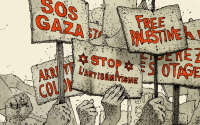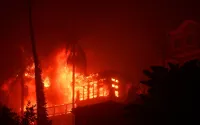Common Dreams / Published on Monday, August 1, 2005 by the Guardian (UK)Jeevan Vasagar
In Tahoua market, there is no sign that times are hard. Instead, there are piles of red onions, bundles of glistening spinach, and pumpkins sliced into orange shards. There are plastic bags of rice, pasta and manioc flour, and the sound of butchers' knives whistling as they are sharpened before hacking apart joints of goat and beef.
A few minutes' drive from the market, along muddy streets filled with puddles of rainwater, there is the more familiar face of Niger. Under canvas tents, aid workers coax babies with spidery limbs to take sips of milk, or the smallest dabs of high-protein paste.
Wasted infants are wrapped in gold foil to keep them warm. There is the sound of children wailing, or coughing in machine-gun bursts.
"I cannot afford to buy millet in the market, so I have no food, and there is no milk to give my baby," says Fatou, a mother cradling her son Alhassan. Though he is 12 months old he weighs just 3.3kg (around 7lbs).
Fatou, a slender, childlike young woman in a blue shawl, ate weeds to survive before her baby was admitted to a treatment centre run by the medical charity MSF.
This is the strange reality of Niger's hunger crisis. There is plenty of food, but children are dying because their parents cannot afford to buy it.
The starvation in Niger is not the inevitable consequence of poverty, or simply the fault of locusts or drought. It is also the result of a belief that the free market can solve the problems of one of the world's poorest countries.
The price of grain has skyrocketed; a 100kg bag of millet, the staple grain, costs around 8,000 to 12,000 West African francs (around £13) last year but now costs more than 22,000 francs (£25). According to Washington-based analysts the Famine Early Warning System Network (Fewsnet), drought and pests have only had a "modest impact" on grain production in Niger.
The last harvest was only 11% below the five-yearly average. Prices have been rising also because traders in Niger have been exporting grain to wealthier neighbouring countries, including Nigeria and Ghana.
Niger, the second-poorest country in the world, relies heavily on donors such as the EU and France, which favour free-market solutions to African poverty. So the Niger government declined to hand out free food to the starving. Instead, it offered millet at subsidised prices. But the poorest could still not afford to buy.
At Tahoua market the traders are reluctant to talk about the hunger crisis affecting their countrymen as they spread their wares under thatched verandas jutting out from mud buildings. Snatches of the Qur'an from tinny tape players compete with Bollywood songs and the growl of lorries bringing sacks of rice and flour.
One man opens his left palm to display half a dozen tiny scorpions, a living advert for the herbal scorpion antidote he is selling in his other hand.
Omar Mahmoud, 18, who helps sell rice at his father's shop, blames the famine on drought: "I know there is hunger. It is because there wasn't enough rain. The price of millet has gone up because there wasn't enough rain last year."
Last month around 2,000 protesters marched through the streets of the capital, Niamey, demanding free food. The government refused. The same month, G8 finance ministers agreed to write off the country's $2bn (£1.3bn) debt.
"The appropriate response would have been to do free food distributions in the worst-affected areas," said Johanne Sekkenes, head of MSF's mission in Niger.
"We are not speaking about free distribution to everybody, but to the most affected areas and the most vulnerable people."
The UN, whose World Food Programme distributes emergency supplies in other hunger-stricken parts of Africa, also declined to distribute free food. The reason given was that interfering with the free market could disrupt Niger's development out of poverty.
"I think an emergency response should have started much earlier," says Ms Sekkenes. "Now we find ourselves in this serious nutritional crisis, with children under five who are suffering."
Three weeks ago the Niger government, its foreign donor countries and the UN did a volte-face, jointly agreeing to allow the distribution of free food. Aid is now being flown in from Europe and trucked from neighbouring countries.
A total of 3.6 million people live in the regions of Niger affected by the food crisis. According to the most reliable estimate, some 874,000 people now need free food to survive.
The food aid will arrive as children weakened by hunger face a new battle against disease. It is the rainy season in Niger, and the water helps spread diseases such as malaria and diarrhoea.
In the MSF treatment centre, a three-year-old girl called Aminata is suffering from a grotesque eye condition. Her eyeball is so swollen with fluid that it has popped out of her skull and bulges from her face. The doctors call it a retinal blastoma, the result of an untreated eye infection.
"The thing in her eye started off very small," said Aminata's mother, Nisbou. "I did not have money for hospital, so I treated it with herbs, traditional medicine."
The hunger crisis has struck communities which depend on a mix of subsistence farming and herding for their livelihoods. The stories told by the women in the treatment centre show that their plight began when locusts ate their crop and cattle fodder, but spiralled when the prices of food in the market shot out of reach.
In desperate times, adults can get by on the poorest of foods, weeds and the stubble of their crops, but mothers cannot make breastmilk on this diet and infants cannot eat weeds.
Amid the anxiety, there are unexpected moments of gaiety in the feeding centre. Asked her age, Nisbou, who is probably about 20, replied: "I am 100 years old." She burst out laughing at her own joke, then looked weary again, and tucked her baby's deformed face under a lace shawl.






